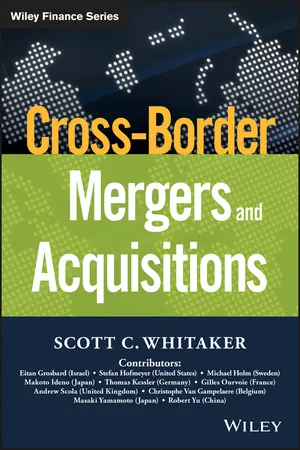
- English
- ePUB (mobile friendly)
- Available on iOS & Android
Cross-Border Mergers and Acquisitions
About this book
Navigate cross border M&A for a flawless integration execution
Cross Border Mergers and Acquisitions is a practical toolbox for corporate strategy and development professionals dealing with the many challenges involved in cross border M&A. With a detailed discussion of key market specifics and broadly-applicable critical insight, this book demystifies the cross border M&A process and provides a host of practical tools that ease strategic implementation. A geographical overview explains the trends in major M&A markets including Australia, Brazil, China, Russia, the U.K., and the U.S., and industry-specific guidance covers Financial Services, Aerospace and Defense, Health Care, Tech, Manufacturing, and more. Leading experts relate lessons learned while managing actual PMI (post merger integration)processes, and the discussion of cultural impacts and specific situational needs provides deep insight into the type of leadership a flawless integration requires.
Corporate restructuring and internationalization efforts are increasingly relying on cross border mergers and acquisitions. Strategies, motives, and consequences are a complex navigational minefield, but this insightful guide provides solid, actionable guidance for leading a successful integration.
- Understand the region-specific details that make an impact
- Overcome common challenges and manage complex deals
- Gain practical insight and valuable tools for leading integration
- Learn the most current best practices for PMI® processes
Cross border M&A is complex, with myriad challenges and obstacles inherent to the situation. Successful integration and a smooth transition are critical, and there's little wiggle room—it's a situation where you have only one chance to get it right. Cross Border Mergers and Acquisitions is an essential guide to the process, with key tools for execution.
Frequently asked questions
- Essential is ideal for learners and professionals who enjoy exploring a wide range of subjects. Access the Essential Library with 800,000+ trusted titles and best-sellers across business, personal growth, and the humanities. Includes unlimited reading time and Standard Read Aloud voice.
- Complete: Perfect for advanced learners and researchers needing full, unrestricted access. Unlock 1.4M+ books across hundreds of subjects, including academic and specialized titles. The Complete Plan also includes advanced features like Premium Read Aloud and Research Assistant.
Please note we cannot support devices running on iOS 13 and Android 7 or earlier. Learn more about using the app.
Information
PART One
Cross-Border Strategy and Deal Planning
CHAPTER 1
Cross-Border Deal Evolution and Rationale
CHAPTER LEARNING OBJECTIVES—IN THIS CHAPTER, YOU WILL LEARN:
- How cross-border deals have evolved over time and what key lessons we can draw from such analysis.

- At the firm level, what the main strategic motives are for cross-border deals and to what extent microeconomic factors influence the success of a deal.

- More generally, what the main factors influencing cross-border deals are, from global to micro levels, and how they can be correlated with cross-border deal success.

CHAPTER SUMMARY
THE EVOLUTION OF M&A AND CROSS-BORDER DEALS
M&A: A Resilient Market1
A Geographically Spreading Market
Table of contents
- Cover
- Praise
- Title page
- Copyright
- Dedication
- Preface
- About the Author
- About the Contributors
- PART One Cross-Border Strategy and Deal Planning
- PART Two Cross-Border Culture and Leadership Alignment
- PART Three Cross-Border Integration, Planning, and Execution
- PART Four Unique Cross-Border M&A Transaction Scenarios
- Index
- EULA